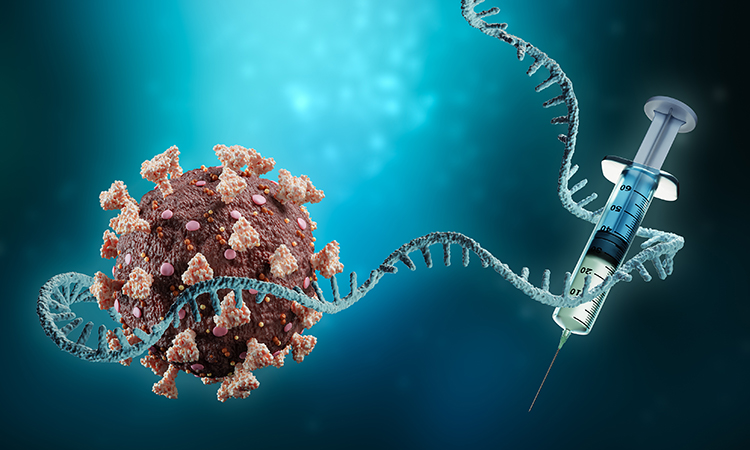mRNA vaccine technology – a promising platform for novel vaccine development
Posted: 13 December 2021 | Dr Pushpanathan Muthuirulan (Harvard University) | No comments yet
Dr Pushpanathan Muthuirulan explores why messenger RNA (mRNA) is advantageous for vaccine development and how the COVID-19 pandemic has accelerated its progress within the pharmaceutical industry.


Infectious diseases remain the leading cause of death worldwide, despite the development and availability of antibiotic therapies. COVID-19, the respiratory disease caused by the novel SARS‑CoV-2, spread rapidly all over the world and has resulted in severe mortality in the elderly and those with associated comorbidities. Vaccines are one of the most effective ways to end the ongoing pandemic, which help boost the immune system to develop protection against COVID-19.
Traditional vaccine discovery approaches offered three forms of vaccines: attenuated vaccines, modified live vaccines (MLVs) and subunit vaccines. Not all infectious disease-causing agents can be cultured under laboratory conditions and some agents may require specific growth conditions, including expensive cell culture media. Besides these challenges, traditional vaccine discovery approaches also consume more time, taking years and sometimes even decades to develop, test and approve for public use.
Obtaining rationally attenuated strains or highly purified antigenic components using recombinant DNA technologies has accelerated the vaccine discovery process, which is undoubtedly a great success of modern technology that offers innovative approaches to address existing challenges of vaccine development. Since the discovery of mRNA in 1961 by Brenner et al, the ability to use mRNA for therapies was described in 1989. Hundreds of scientists had already worked on an mRNA vaccine for decades before the coronavirus pandemic bought a scientific breakthrough. mRNA vaccines have been shown to elicit robust immune response against several infectious agents such as influenza virus, Zika virus, rabies virus and MERS-CoV and SARS‑CoV-2 viruses. mRNA vaccine technology is a new era for vaccine technology and production as well as a testament to scientific progress and decades of research.
The synthetic production of the mRNA encoding any protein of interest enables researchers to rapidly produce and test any viral epitopes/antigens in pre‑clinical models, which can dramatically accelerate the vaccine selection process. Also, mRNA vaccines have several advantages over DNA vaccines as they induce immune response at a very low concentration, possess high efficacy, safety, speed of development and have production scalability and reliability. In addition, mRNA does not integrate into the cell’s genome and no transcriptional step is required, as the mRNA molecule is directly translated and undergoes degradation. Like live attenuated vaccines, mRNA vaccines can also activate cellular and humoral immune responses.
Vaccines are one of the most effective ways to end the ongoing pandemic”
The side effects associated with mRNA vaccines are very rare and it ranges from mild-to-moderate with no severe-grade local side effects or allergic reactions. Recently, the US Centers for Disease Control and Prevention (CDC) conducted analyses on 4,000 healthcare workers by testing each worker weekly for coronavirus after mRNA vaccine administration. The analyses found that individuals who had received complete vaccination had a 90 percent reduced chance of becoming infected. Furthermore, the study also showed that the administration of a first dose alone can reduce the percentage of infection close to 80 percent. This study clearly demonstrates the ability of mRNA vaccines to stop the viral spread and help develop desirable protection against COVID-19.
Overall, mRNA vaccine development has undergone a tremendous drive within the pharmaceutical field and it serves as a promising novel platform for the development of new vaccines against emerging pandemic infectious diseases. Scientists are hopeful that the mRNA technology used in COVID-19 vaccines could be the turning point in the long history of vaccine development and could lead to major advances in the creation of new vaccines that minimise the burden of diseases such as HIV and cancer.
About the author
Dr Pushpanathan Muthuirulan is currently a Research Associate at Harvard University studying the developmental and genetic basis of human height variations using functional genomics approaches. Previously, he worked as a Postdoctoral Researcher at the National Institutes of Health, where his research focused on developing state‑of‑the‑art technologies using CRISPR-Cas9 and super‑resolution microscopy to map neural circuits that involves visual motion information processing in Drosophila. His expertise lies in omics technologies, drug discovery, neuroscience and developmental and evolutionary genetics.
Related topics
Drug Development, Immunology, RNAs, Vaccine
Related conditions
Covid-19, Middle East Respiratory Syndrome (MERS), rabies, Zika virus
Related organisations
US Centers for Disease Control and Prevention (CDC)








